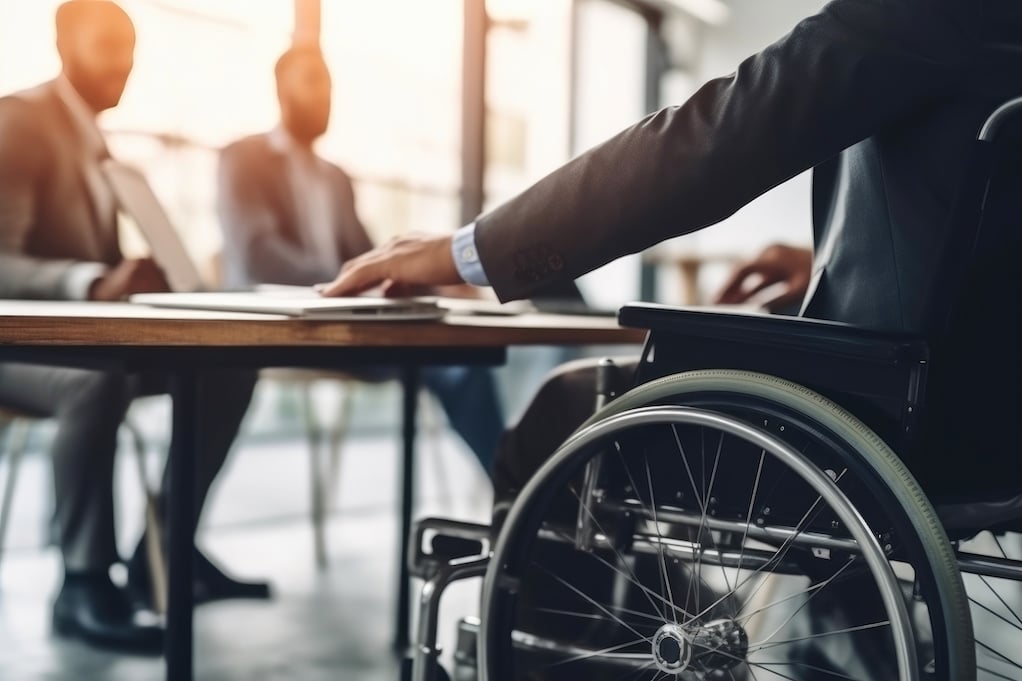In an era where diversity and inclusivity reign supreme, office accessibility has shifted from being a mere obligation to a fundamental consideration in design.
As a market driven by post-pandemic dynamics, there is a new emphasis on the importance of accessible office designs. They not only demonstrate care for employees but also align with broader equality and ESG goals. This shift in perspective has made accessibility a priority, going beyond compliance to create spaces that truly cater to everyone.
As work dynamics evolve, the significance of accessible offices has amplified. Ensuring inclusivity is not just a legal necessity, but a strategic element for occupiers to facilitate a safe and productive return to the workplace. Additionally, from a leasing standpoint, landlords recognize the tenant appeal of spaces that consider diverse requirements. So ensuring accessibility in coming years will only grow in importance.
So, let’s delve into key insights for tenants embarking on the path to crafting workplaces that optimize to everyone's needs.
1. ADA Compliance is a Bare Necessity
Office tenants should be aware of the Americans with Disabilities Act (ADA) requirements, which ensure that their workplace provides a welcoming environment to employees and visitors with disabilities. ADA compliance serves as the foundational framework for ensuring office accessibility and enable equal access.
Passed in 1991, the legislation had sweeping affects on the construction and layout of public spaces. You'd be hard-pressed not to find an ADA adherent building now. With 3+ decades of ensuring compliance under their belt, commercial landlords understand that the responsibility is on them to ensure inclusivity creating accessible entrances, restrooms, pathways, and facilities.

For example, ADA-compliant offices feature accessible entrances with ramps or elevators, wider doorways to accommodate wheelchairs, properly positioned signage, and accessible restrooms with features like grab bars and lowered sinks. Workstations are designed to accommodate individuals with diverse needs, such as adjustable desks, ergonomic chairs, and technology with adaptable interfaces. Additionally common areas and parking should also be accessible. This will influence the space you lease as a tenant.
|
“The physical footprint of an occupier’s space will need to be larger to accommodate, for example, wheelchair users who will need more space in all areas of an office for turning diameters. “ -Propmodo |
Understanding ADA standards for is essential for corporate tenants. But, at the end of the day, it's something that should be built into your landlord's existing office facilities.
And while ADA compliance is a critical starting point, it's important to recognize that true accessibility goes beyond the minimum legal requirements. Embracing universal design principles takes accessibility to the next level by creating environments that naturally cater to a wide range of abilities and needs.
Don't get left behind, stay on top of the latest trends in the CRE world.
2. Universal Design and the Flight to Quality
When it comes to office spaces, the universal design approach is booming in popularity. Essentially, it's all about making everyone feel at home. It goes beyond mere compliance with basic accessibility standards like the Americans with Disabilities Act (ADA) and focuses on designing environments that naturally accommodate a diverse range of people.
And this means recognizing that office space has taken on a new role in a post-pandemic environment. Employees expect more from a collaborative space if they literally go the extra mile to make a commute.
Universal design principles emphasize the new expectations of office spaces including flexibility, simplicity, and user-friendliness. And in today’s leasing environment, the most modern-oriented office buildings have the highest demand. Read more about the Flight to Quality in the office market.

To remain competitive in the talent war, businesses are now being urged to consider how they can make their offices more welcoming. Because there has been a great cultural shift and many professionals are deeming that the office should take on an heir more similar to hospitality than compulsory workplace. This means premium amenities, comfortable working spaces, and perhaps most importantly, ease of access.
|
“It’s not just about getting someone from Point A to Point B, but it’s about having that experience as similar and as enjoyable as it is for everyone else.“ -Propmodo |
That means landlords who jump on board (perhaps with a new Tenant Improvement Allowance) will see a more impressive return than those with outdated buildings that harm a corporation’s ESG compliance.
In context of accessibility, this involves thoughtful choices in the construction of layouts, furniture, signage, technology, and more to ensure that every person can navigate the office comfortably, interact with equipment, communicate effectively, and carry out tasks without unnecessary barrier
|
“Making sure an office is accommodating to the whole spectrum of disabilities not only shows respect and care for employees, it can help bolster occupiers’ back-to-work plans and satisfy landlords looking to keep their buildings full and occupiers happy”“ -Propmodo |
But this is not where accessibility begins and ends. New standards demand that businesses rethink offices according to the evolving definition of disabilities and how they may appear. This requires thinking outside the box to optimize everyone’s experience who visits the office.
3. Accessibility Planning is Designing for Equal Access
Office disability planning is undergoing a transformative shift, embracing the concept of designing for everyone.
Traditionally, disability planning mainly focused on physical accessibility, ensuring that spaces were equipped with ramps, wider doorways, and accessible restrooms. However, as our understanding of disabilities evolves, so does our approach to planning. Today, it's not just about accommodating physical limitations; it's about considering a broader spectrum of disabilities, including those that may not be immediately visible.

Companies are increasingly realizing the importance of creating environments that support neurodiversity. This means designing spaces that cater to a variety of sensory needs. For instance, individuals with hypersensitivity to light or touch may benefit from adjustable lighting and sound-absorbing materials.
|
“There’s a recognition that people experience things in different ways and not one-size-fits-all, so how can we design spaces and places and environments to help people feel safe and well and flourish.” -Propmodo |
The key shift is moving from a one-size-fits-all model to one that recognizes and embraces individual differences. This includes designing spaces that offer a range of sensory experiences, allowing each employee to tailor their environment to their unique needs. For example, in a hybrid-friendly office, accessible technology is of the utmost importance.
Technology solutions should be accessible to everyone especially when certain neurological conditions can be triggered by technology. Screen readers, voice-activated systems, adjustable monitors, and ergonomic keyboards can make digital interactions more inclusive.

Improving workplaces can only be successfully achieved through proper workforce management. This involves analyzing usage patterns and employee preferences. Businesses are now more than ever investing time and resources to understand what drives the volume of employees and behaviors.
By doing so, offices become more than just physically accessible – they become spaces where all individuals can feel safe, comfortable, and empowered to thrive.
What Tenants Should Know About Accessible Offices
Creating an accessible safe, and technologically adept workplace is a delicate balancing game.
We understand that there are different standards in regard to how the office is used but adapting requires identifying the employee behaviors largely taking place. Landlords and businesses need to pay attention to these trends and adapt their methodology to create a hospitable yet secure first point of contact for their employees and visitors. Not only will this make them more enticing, but it will place them ahead of the curb of an evolution that is only sure to become more rapid.
By embracing the principles of universal design and staying informed about evolving accessibility standards, tenants can shape offices that reflect their commitment to their employees' well-being and growth. Stay on top of the latest trends in the commercial real estate world and learn the techniques to ensure your individual offices and portfolio are reaching their optimal performance. Son't miss out and subscribe to our blog.








